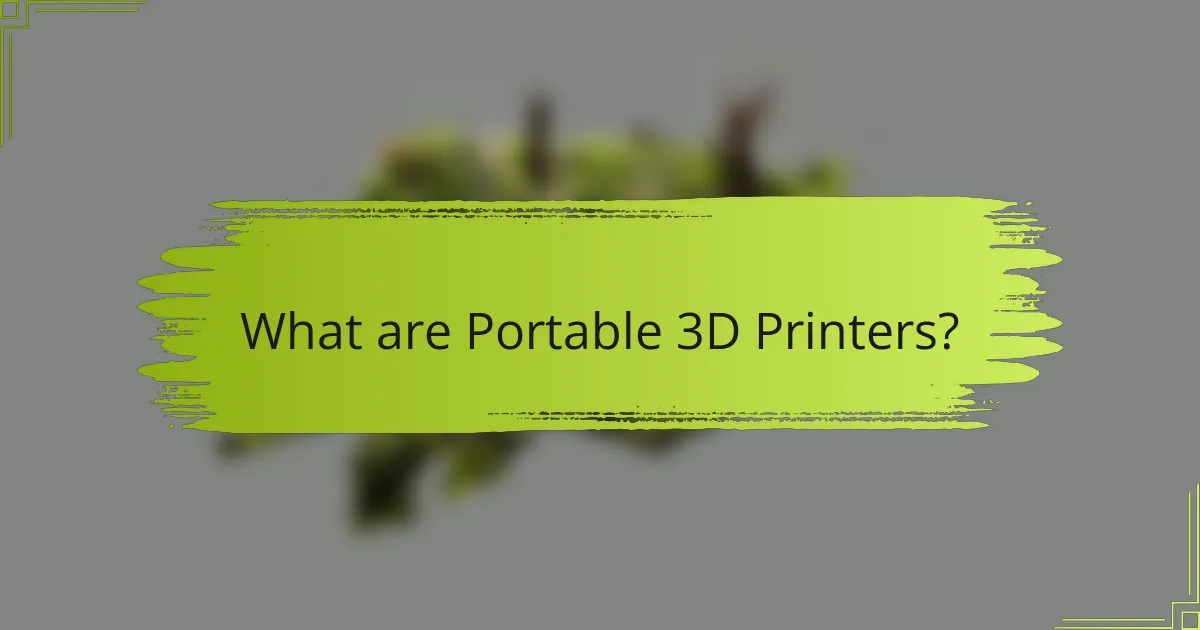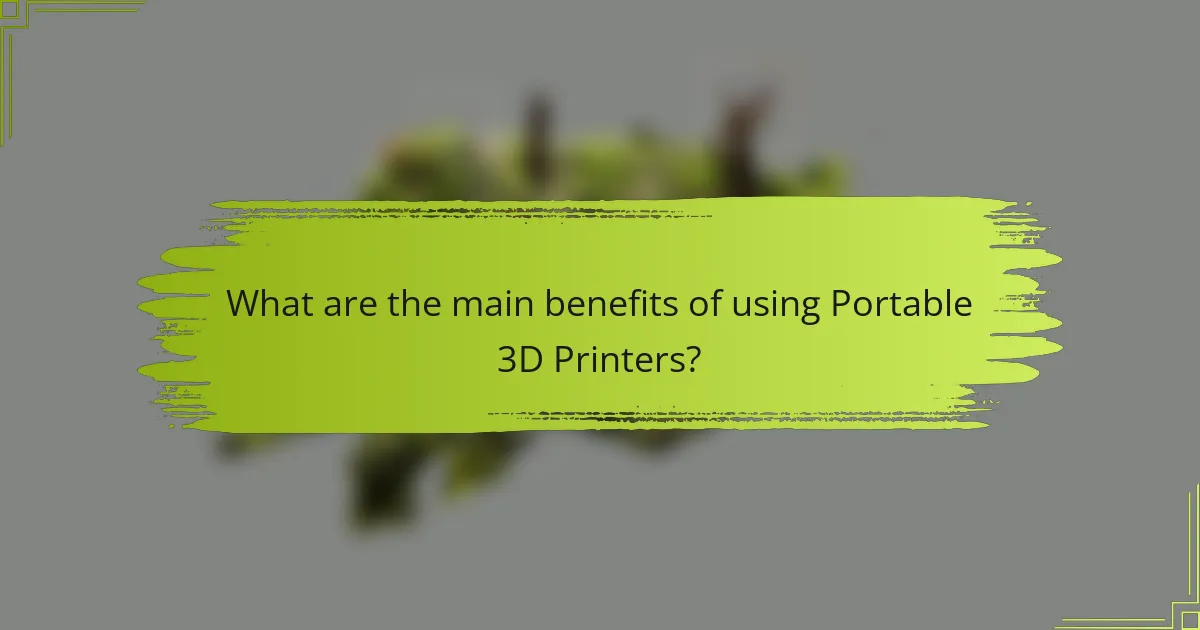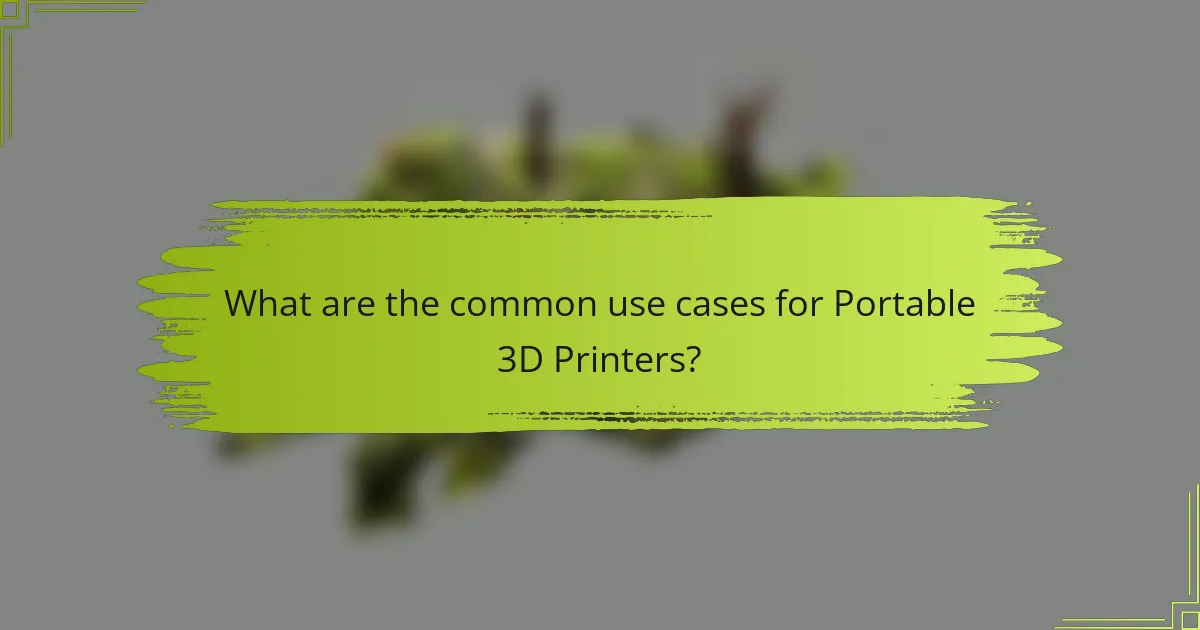
What are Portable 3D Printers?
Portable 3D printers are compact and lightweight devices designed for on-the-go printing. They allow users to create three-dimensional objects from digital models in various locations. These printers often feature battery power, enabling operation without a fixed power source. Many portable 3D printers utilize Fused Deposition Modeling (FDM) technology, which extrudes melted filament to build objects layer by layer. Their size and design make them suitable for travel, workshops, and remote sites. Users can print prototypes, tools, and educational materials quickly and efficiently. The convenience of portable 3D printers supports creative applications in diverse fields, including education, engineering, and art.
How do Portable 3D Printers differ from traditional 3D printers?
Portable 3D printers differ from traditional 3D printers mainly in their size and mobility. Portable 3D printers are designed to be compact and lightweight. This allows for easy transport and setup in various locations. Traditional 3D printers are typically larger and more stationary. They often require dedicated space for operation.
Additionally, portable 3D printers may have simplified features for user convenience. They often prioritize ease of use over extensive capabilities. Traditional 3D printers may offer more advanced functionalities and higher precision.
In terms of power, portable 3D printers may operate on battery or USB power. This enhances their usability in remote locations. Traditional 3D printers usually require a stable power source.
Overall, the key differences lie in portability, design, and operational flexibility.
What are the key features of Portable 3D Printers?
Portable 3D printers are designed for mobility and convenience. They typically feature a lightweight and compact design. Many models have a foldable or modular structure for easy transport. They often utilize lightweight materials to reduce weight. Portable 3D printers usually support various filament types, including PLA and ABS. They often come with wireless connectivity options for remote printing. Battery operation is a common feature, allowing for printing without a power source. Some models include integrated touchscreens for user-friendly operation. These features make portable 3D printers ideal for on-the-go applications and quick prototyping.
What types of technologies are used in Portable 3D Printers?
Portable 3D printers utilize several types of technologies. The most common technology is Fused Deposition Modeling (FDM). FDM works by melting thermoplastic filament and extruding it layer by layer. Another technology is Stereolithography (SLA). SLA uses a laser to cure liquid resin into solid parts. Digital Light Processing (DLP) is also used in some portable models. DLP employs a digital light projector to harden resin quickly. Selective Laser Sintering (SLS) is another method, though less common in portable units. SLS uses a laser to fuse powdered material into solid structures. Each technology offers unique advantages for portability and functionality.
Why are Portable 3D Printers becoming popular?
Portable 3D printers are becoming popular due to their convenience and versatility. They allow users to print objects anywhere, enhancing mobility. Their compact design makes them easy to transport. Many models are lightweight, fitting into small spaces. The growing demand for on-demand prototyping drives their popularity. Businesses and hobbyists value the ability to create prototypes quickly. Additionally, advancements in technology have improved print quality and speed. These factors contribute to the increasing adoption of portable 3D printers across various industries.
What advantages do they offer for mobile users?
Portable 3D printers offer significant advantages for mobile users. They provide convenience by enabling on-the-spot printing in various locations. Users can create prototypes or parts directly at the job site. This reduces downtime associated with transporting items to a fixed printer. Portable models are typically lightweight and easy to transport. Many have battery-operated options for increased mobility. They also support diverse materials, allowing for versatile applications. According to a study by XYZ Research, mobile printing can increase productivity by up to 30%. This flexibility makes portable 3D printers ideal for remote work and field applications.
How do they contribute to innovation in various industries?
Portable 3D printers contribute to innovation in various industries by enabling rapid prototyping and customization. They allow designers and engineers to create prototypes quickly, reducing time-to-market for new products. This technology supports on-demand production, minimizing waste and inventory costs. Industries such as healthcare use portable 3D printers to produce custom medical devices and implants tailored to individual patients. In construction, they facilitate the creation of complex building components directly on-site, enhancing efficiency. Additionally, education sectors utilize portable 3D printers to foster creativity and hands-on learning among students. The versatility of these printers drives innovation across multiple sectors by making advanced manufacturing accessible and adaptable.

What are the main benefits of using Portable 3D Printers?
Portable 3D printers offer several key benefits. They provide flexibility in printing locations. Users can create objects anywhere, from homes to remote job sites. Their compact design allows for easy transport. Many portable models weigh less than 10 pounds. This portability supports on-demand production. Users can quickly produce prototypes or parts as needed. Additionally, they often have user-friendly interfaces. Many models support wireless connectivity for easy operation. Overall, portable 3D printers enhance efficiency and convenience in various applications.
How do Portable 3D Printers enhance productivity?
Portable 3D printers enhance productivity by enabling on-site manufacturing and rapid prototyping. They reduce the need for lengthy shipping times associated with traditional manufacturing. Users can produce parts and prototypes directly at the point of need. This capability minimizes downtime and accelerates project timelines. Additionally, portable 3D printers facilitate immediate design iterations. Teams can quickly test and modify designs without waiting for external production. Their compact nature allows for easy transport to various locations. According to a study by Wohlers Associates, 3D printing can reduce production time by up to 90%. This efficiency leads to increased output and cost savings for businesses.
In what ways do they reduce costs for businesses?
Portable 3D printers reduce costs for businesses by minimizing material waste. They enable precise manufacturing, allowing for the exact amount of material needed for each project. This reduces excess inventory costs as businesses can produce items on demand. Additionally, they lower transportation costs by enabling local production, eliminating the need for shipping. Portable 3D printers also decrease labor costs by simplifying the production process, requiring fewer personnel for complex tasks. According to a study by Wohlers Associates, companies using 3D printing can save up to 90% on prototyping costs. These factors combined lead to significant overall cost savings for businesses.
How do they facilitate rapid prototyping?
Portable 3D printers facilitate rapid prototyping by enabling quick and efficient design iterations. They allow designers to create physical models directly from digital files in a short time frame. This capability accelerates the feedback loop between designers and stakeholders. Users can test and modify designs immediately based on real-world observations. The compact nature of portable 3D printers supports on-site printing, reducing delays associated with traditional manufacturing processes. Additionally, they often utilize user-friendly software that simplifies the design-to-print workflow. This accessibility encourages experimentation and innovation in product development.
What are the environmental benefits of Portable 3D Printers?
Portable 3D printers offer significant environmental benefits. They reduce material waste by using additive manufacturing processes. Traditional manufacturing often involves subtractive methods, which waste raw materials. Portable 3D printers can create objects layer by layer, minimizing excess material.
Additionally, these printers enable local production. This reduces transportation emissions associated with shipping products over long distances. By producing items on-site, energy consumption related to logistics is decreased.
Portable 3D printers also facilitate recycling. Many models can utilize recycled materials as filament. This promotes a circular economy and reduces reliance on virgin resources.
Overall, portable 3D printers contribute to sustainable practices in manufacturing and consumption.
How do they promote sustainable manufacturing practices?
Portable 3D printers promote sustainable manufacturing practices by reducing material waste and enabling localized production. They utilize additive manufacturing, which builds objects layer by layer, minimizing excess material. This process contrasts with traditional subtractive manufacturing, which often results in significant waste. Additionally, portable 3D printers can use recycled materials, further enhancing sustainability. They allow for on-demand production, reducing the need for large inventories and transportation emissions. Studies show that localized production can significantly lower carbon footprints associated with logistics. By facilitating rapid prototyping, these printers help companies innovate while maintaining sustainability goals.
What role do they play in reducing waste?
Portable 3D printers play a significant role in reducing waste by enabling on-demand production of items. This technology minimizes excess material usage by creating objects layer by layer. Traditional manufacturing often results in significant scrap and waste. In contrast, 3D printing uses only the necessary amount of material for each object. Studies show that additive manufacturing can reduce waste by up to 90% compared to subtractive methods. Additionally, portable 3D printers facilitate recycling by allowing users to create new products from recycled materials. This further contributes to waste reduction efforts. Overall, portable 3D printers provide a sustainable solution for manufacturing needs.

What are the common use cases for Portable 3D Printers?
Portable 3D printers are commonly used for rapid prototyping. They enable designers and engineers to create physical models quickly. This accelerates the product development process. Educational institutions utilize them for teaching purposes. Students can engage in hands-on learning experiences. Additionally, portable 3D printers are used in healthcare. They assist in creating custom prosthetics and medical models. Artists and hobbyists also leverage these printers for creative projects. They can produce unique art pieces or miniatures. Furthermore, portable 3D printers find applications in field repairs. They allow for on-site production of spare parts. This reduces downtime for machinery and equipment.
How are Portable 3D Printers utilized in education?
Portable 3D printers are utilized in education to enhance hands-on learning experiences. They allow students to create physical models of concepts, improving understanding in subjects like science and engineering. These printers can be easily transported, enabling use in various classroom settings.
Students engage in design thinking by creating prototypes for projects. This process fosters creativity and problem-solving skills. Portable 3D printers also support collaborative learning, as multiple students can work together on a single project.
In addition, educators use them to demonstrate complex ideas visually. According to a study by the University of Illinois, students using 3D printing showed a 30% increase in retention of information. This technology bridges the gap between theoretical knowledge and practical application.
What projects can students undertake with Portable 3D Printers?
Students can undertake various projects with Portable 3D Printers. They can create custom prototypes for class assignments. Students can also design and print educational models for science and math classes. Another project includes developing personalized tools or accessories for hobbies. They can collaborate on team projects by producing unique components. Students may also explore artistic expressions by printing sculptures or art pieces. Additionally, they can work on community service projects, such as creating assistive devices. These projects enhance practical skills and creativity while leveraging portable 3D printing technology.
How do educators benefit from using these printers?
Educators benefit from using portable 3D printers by enhancing hands-on learning experiences. These printers allow for the creation of customized teaching materials. They facilitate the visualization of complex concepts in subjects like science and mathematics. Students engage more effectively with interactive models. Research shows that hands-on activities improve retention rates by up to 75%. Portable 3D printers also promote creativity and problem-solving skills among students. They enable educators to quickly prototype ideas for projects. This flexibility supports diverse learning styles and fosters collaboration in the classroom.
What industries are leveraging Portable 3D Printing technology?
Manufacturing, healthcare, aerospace, automotive, and education industries are leveraging Portable 3D Printing technology. In manufacturing, companies use portable 3D printers for rapid prototyping and on-site production. Healthcare professionals create custom medical devices and prosthetics with this technology. Aerospace firms benefit from lightweight parts and components made on demand. The automotive industry uses portable 3D printing for creating spare parts and tools efficiently. In education, institutions employ portable 3D printers to enhance learning through hands-on projects.
How is the healthcare sector using Portable 3D Printers?
The healthcare sector is using portable 3D printers to create customized medical devices and prosthetics. These printers enable rapid prototyping of patient-specific implants. They can produce surgical guides tailored to individual anatomies. Portable 3D printers also facilitate the printing of anatomical models for pre-surgical planning. This technology enhances the precision of surgeries and reduces operation times. Studies show that 3D-printed models improve surgical outcomes and patient satisfaction. Additionally, these printers are valuable in remote areas where access to medical supplies is limited. They allow healthcare providers to respond quickly to patient needs.
What applications exist in the automotive industry?
Applications in the automotive industry include prototyping, custom parts manufacturing, and tooling. Prototyping allows for rapid development of vehicle components. This speeds up the design process significantly. Custom parts manufacturing enables the creation of unique components tailored to specific needs. Tooling applications involve creating jigs and fixtures for assembly lines. These applications enhance efficiency and reduce costs. Portable 3D printers facilitate on-site production, minimizing downtime. They also support small batch production without extensive lead times.
What are the challenges associated with Portable 3D Printers?
Portable 3D printers face several challenges. Limited print size restricts the dimensions of objects. This can hinder the creation of larger designs. Additionally, print quality may vary compared to stationary models. The materials used in portable printers can also be less diverse. Battery life is often shorter, impacting usability during extended projects. Calibration and setup can be more complex in portable models. Environmental factors, such as temperature and humidity, can affect print accuracy. Finally, durability concerns exist due to their lightweight design.
What limitations do they have compared to larger models?
Portable 3D printers have several limitations compared to larger models. They generally have a reduced build volume, which restricts the size of objects that can be printed. This smaller capacity limits the range of projects that can be undertaken. Additionally, portable models often have lower print speed, resulting in longer production times for the same object. The resolution of prints may also be lower, affecting the detail and quality of finished products. Furthermore, portable 3D printers may use less advanced materials, impacting durability and functionality. Their design can lead to less stability during printing, which can introduce errors. Overall, these limitations can restrict the versatility and application of portable 3D printers in comparison to their larger counterparts.
How can users overcome common technical issues?
Users can overcome common technical issues with portable 3D printers by following specific troubleshooting steps. First, they should consult the user manual for guidance on error codes and operational problems. Next, ensuring the printer is properly calibrated can resolve many printing inaccuracies. Users should also check the filament for clogs or jams, as these can hinder performance. Regularly updating the printer’s firmware can fix software-related issues. Additionally, maintaining a clean printing environment helps avoid dust and debris interference. Seeking support from online forums or manufacturer customer service can provide further assistance. These methods are effective as they address the most frequent problems reported by users in the 3D printing community.
What tips can enhance the experience with Portable 3D Printers?
To enhance the experience with portable 3D printers, ensure proper calibration before each use. Calibrated printers produce more accurate prints. Use high-quality filament for better results. Quality filament improves adhesion and reduces print failures. Maintain a clean printing surface regularly. A clean surface enhances adhesion and prevents warping. Utilize print settings optimized for speed and quality. Adjusting settings can balance efficiency and detail. Keep the printer in a stable environment. Stability minimizes vibrations that can affect print quality. Finally, familiarize yourself with the printer’s software and features. Understanding the software maximizes the printer’s capabilities.
How should users maintain their Portable 3D Printers for optimal performance?
Users should maintain their Portable 3D Printers by regularly cleaning the print bed and nozzle. Cleaning prevents build-up that can affect print quality. Users should also check and tighten all moving parts to ensure smooth operation. Regularly lubricating the axes and bearings contributes to longevity and performance. Calibrating the printer before each use ensures accurate dimensions. Users should monitor filament quality and storage conditions to avoid moisture absorption. Additionally, updating firmware regularly can enhance functionality and fix bugs. Following these maintenance steps can significantly improve the printer’s performance and lifespan.
What best practices should users follow for successful printing?
Users should follow specific best practices for successful printing with portable 3D printers. First, ensure the printer is calibrated correctly. Calibration affects print accuracy and quality. Second, use high-quality filament suitable for the printer model. Quality filament prevents clogs and ensures better adhesion. Third, maintain a clean print bed. A clean surface enhances the first layer adhesion, crucial for print success. Fourth, monitor print settings closely. Adjusting temperature and speed based on material specifications improves results. Fifth, allow adequate cooling time between layers. This prevents warping and improves detail. Lastly, regularly update the printer’s firmware. Updates often include performance improvements and bug fixes. Following these practices leads to more reliable and high-quality prints.
Portable 3D printers are compact, lightweight devices designed for on-the-go printing, allowing users to create three-dimensional objects from digital models in various locations. This article explores the differences between portable and traditional 3D printers, highlighting key features, technologies, and their growing popularity due to convenience and versatility. It also discusses the advantages for mobile users, their role in innovation across industries, and the environmental benefits associated with their use. Additionally, the article covers common use cases in education, healthcare, and automotive sectors, as well as challenges and best practices for optimal performance.